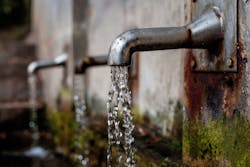Exploring the role of chlorate regulations
Regulatory bodies continually watch water contaminants for potential regulation. One such contaminant that has drawn attention in recent years is chlorate (ClO3-). A highly oxidized form of chlorine, chlorate can be introduced to a water source as an industrial or agricultural contaminant or into finished water as a disinfection byproduct (DBP). As a DBP, chlorate can result from water disinfection with bulk sodium hypochlorite, chlorine dioxide, or hypochlorite formed through electrochlorination (EC) systems.
Chlorate was added to the third Chemical Contaminant List (CCL3) in 2010, indicating that the U.S. Environmental Protection Agency (EPA) is reviewing the compound as a potential candidate for regulation under the Safe Drinking Water Act. In 2014, chlorate was evaluated as a candidate for regulation under the Regulatory Determinations 3 (RD3) program.
While not currently regulated in the United States, the World Health Organization (WHO) recommends a chlorate limit of 0.7 mg/L (700 µg/L) in drinking water. Experts speculate that future regulation may fall within the range of 0.21 mg/L (210 µg/L) to 0.8 mg/L (800 µg/L) in the U.S.
Research studies on factors that influence the introduction of chlorate in drinking water indicate that, in hypochlorite disinfectant, chlorate mainly arises as a degradation product of hypochlorite ions. Hypochlorite degradation is exacerbated by several factors, including:
• Freshness of solution
• Concentration of delivered solution
• Storage temperature
• Solution pH
If chlorate is regulated as a DBP, most utilities that use bulk hypochlorite will need to make costly operational changes to avoid exceeding regulatory limits. Changes that may address the issue include:
• Cooling of the room where the hypochlorite is stored to slow degradation.
• Requiring “born-on date” labeling from manufacturers.
• Limiting storage volumes.
• Purchasing lower concentrations to slow hypochlorite degradation.
• Dilution of the concentrated hypochlorite once it has been delivered.
An alternative to these methods is on-site generation. On-site generation uses basic, simple chemicals to generate oxidant at the point of use and is often used for safety, environmental, and cost benefits. In this case, the hypochlorite is created by mixing softened water with salt to form saturated brine. The saturated brine enters the electrolytic cell, an electrical current is passed through the electrolytic cell, and the oxidant is produced. On-site generation systems may address some of the concerns around chlorate formation.
Chlorate is expected to be regulated by the EPA, likely at or near the international WHO Guideline of 0.7 mg/L (700 µg/L). Systems that produce chlorate at a rate of less than 40 micrograms (0.04 mg) per milligram of free available chlorine (FAC) will be well below proposed regulatory levels. Since the hypochlorite solution is generated on-site, as needed, storage time is typically 24 hours or less, minimizing hypochlorite degradation. Additionally, hypochlorite solution that is generated at less than 1 percent chlorine concentration also reduces the chorine degradation rate.
Continued research to understand the mechanisms resulting in the production of chlorate during electrolysis will ensure that on-site sodium hypochlorite products will be able to meet future chlorate regulatory requirements. WW
About the Author
Emile Musallam
Emile Musallam is regional sales manager at DeNora Water Technologies Inc., as well as a member of the Water and Wastewater Equipment Manufacturers Association (WWEMA) Board of Directors. For more information about WWEMA, go to www.wwema.org. Interested in becoming a WWEMA member? Contact WWEMA Executive Director Vanessa Leiby at [email protected].
